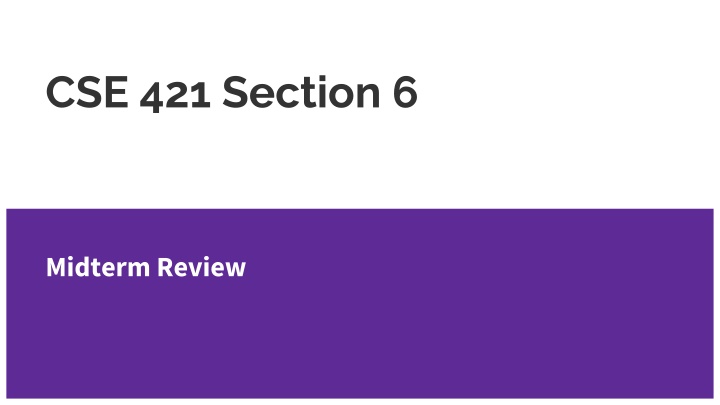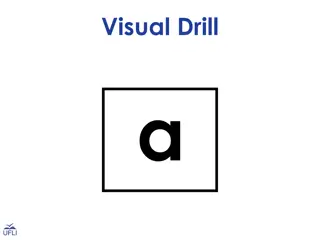
CSE 421 Section 6 Midterm Review Details and Options
The review provides information about the upcoming CSE 421 Section 6 midterm exam, including its format, announcements, reminders, and review session details. It outlines the midterm format, topics covered, and options for practicing exam problems through stations or group work. The review emphasizes key dates, guidelines for the exam, and helpful resources for students to prepare effectively.
Download Presentation

Please find below an Image/Link to download the presentation.
The content on the website is provided AS IS for your information and personal use only. It may not be sold, licensed, or shared on other websites without obtaining consent from the author. If you encounter any issues during the download, it is possible that the publisher has removed the file from their server.
You are allowed to download the files provided on this website for personal or commercial use, subject to the condition that they are used lawfully. All files are the property of their respective owners.
The content on the website is provided AS IS for your information and personal use only. It may not be sold, licensed, or shared on other websites without obtaining consent from the author.
E N D
Presentation Transcript
CSE 421 Section 6 Midterm Review
Announcements & Reminders HW4regrade requests are open HW5 will be due 2/14 There is no homework this week. Your midterm exam is on Wednesday, 2/19 @ 6:00 7:30pm, BAG131 Let us knowASAP if you cannot make it Review session on 2/18 @ 4:30 - 6:30, Location TBD
Midterm format Several multiple choice/short answer problems 3 long-form problems Similar in style to homework 90 minutes You will be given a standard reference sheet, view it on Ed You may bring one sheet of double sided 8.5x11 paper containing your own handwritten notes. Must write name, student number, and UW NetID Must turn in with exam
Option 1 1. (35 min) 6 stations around the room with practice problems Station 1: Short answer Station 2: Stable matching reduction* Station 3: Graph algorithms Station 4: Greedy algorithms* Station 5: Divide and conquer* Station 6: Dynamic programming 2. (10 min) Go over some of these problems *the problem at this station was an extra problem on a previous section handout
Option 2 1. (35 min) Form small groups (1-5 people) and work on problems Station 1: Short answer Station 2: Stable matching reduction* Station 3: Graph algorithms Station 4: Greedy algorithms* Station 5: Divide and conquer* Station 6: Dynamic programming 2. (10 min) Go over some of these problems *the problem at this station was an extra problem on a previous section handout
Option 3 1. (6.5 min) Work on a problem Station 1: Short answer Station 2: Stable matching reduction* Station 3: Graph algorithms Station 4: Greedy algorithms* Station 5: Divide and conquer* Station 6: Dynamic programming 2. (5 min) Go over some of the problem 3. Repeat! *the problem at this station was an extra problem on a previous section handout
Problems 1 3 4 5 6 2 1 3 4 5 6 2
Problem 1 Short answer If ? ranks ? first and ? ranks ? first, then (?,?) must be in every stable matching.
Solution Problem 1 Short answer If ? ranks ? first and ? ranks ? first, then (?,?) must be in every stable matching. True. If ? and ? were not matched, then they prefer each other over the current matches, so this is an instability.
Problem 1 Short answer Running DFS on a directed acyclic graph may produce: Tree edges Back edges Forward edges Cross edges
Solution Problem 1 Short answer Running DFS on a directed acyclic graph may produce: Tree edges Back edges Forward edges Cross edges 1/8 T T F All except back edges, since they create cycles. 6/7 2/5 T C 3/4
Problem 1 Short answer The recurrence ?(?) = 2?(?/3) + (?2) simplifies to ?
Solution Problem 1 Short answer The recurrence ?(?) = 2?(?/3) + (?2) simplifies to ? (?2). By master theorem, since 2 < 32.
Problem 1 Short answer Suppose ? has positive, distinct edge costs. If ? is an MST of ?, then it is still an MST after replacing each edge cost ??with ??2.
Solution Problem 1 Short answer Suppose ? has positive, distinct edge costs. If ? is an MST of ?, then it is still an MST after replacing each edge cost ??with ??2. True. Kruskal s (or Prim s) only depends on the relative order of edge costs. Furthermore, because costs are distinct, there is a unique MST, so Kruskal s algorithm found ? before and will still find ? now.
Problem 1 Short answer Let ? = (?,?) be a weighted, undirected graph. Consider any cut ? ?, and let ? be an edge of minimum weight across the cut ?. Then every MST contains ?.
Solution Problem 1 Short answer Let ? = (?,?) be a weighted, undirected graph. Consider any cut ? ?, and let ? be an edge of minimum weight across the cut ?. Then every MST contains ?. False. The theorem requires edge weights be distinct. Consider: 1 1 1 1 Return to problem select Return to problem select
Problem 2 Stable matching reduction There are ? riders, ? horses with 2? < ? < 3?. Riders and horses have preferences for each other. Also, riders prefer the first 2 rounds. Horses prefer to ride every round. Set up 3 rounds of rides, so that every rider will ride a horse exactly once, every horse does exactly 2 or 3 rides, and there are no unstable matches.
Solution Problem 2 Stable matching reduction There are ? riders, ? horses with 2? < ? < 3?. Riders and horses have preferences for each other. Also, riders prefer the first 2 rounds. Horses prefer to ride every round. Set up 3 rounds of rides, so that every rider will ride a horse exactly once, every horse does exactly 2 or 3 rides, and there are no unstable matches. For all horses , create 1, 2, and 3. Add 3? ? dummy riders. For preference lists: For real riders: original list with 1and 2replacing , then original list with 3 s. For dummy riders: all 3(in any order), then everything else (in any order). For horse-in-rounds: original list, then dummy riders in any order.
Solution Problem 2 Stable matching reduction For all horses , create 1, 2, and 3. Add 3? ? dummy riders. For preference lists: For real riders: original list with 1and 2replacing , then original list with 3 s. For dummy riders: all 3(in any order), then everything else (in any order). For horse-in-rounds: original list, then dummy riders in any order. Then: Every rider is matched because library returns perfect matching. Dummy matched to horse in round 1 or 2 is unstable. Horse and real rider who prefer each other is unstable. Return to problem select Return to problem select
Problem 3 Graph modeling Given ?1,?1, ,(??,??), the person living in unit ??is moving to ??. Some people may be new arrivals (??= null) or moving out (??= null). Give an algorithm that returns a valid moving order (every unit is vacated before someone moves in), or not possible and a minimal list of pairs that explains why.
Solution Problem 3 Graph modeling Given ?1,?1, ,(??,??), the person living in unit ??is moving to ??. Some people may be new arrivals (??= null) or moving out (??= null). Give an algorithm that returns a valid moving order (every unit is vacated before someone moves in), or not possible and a minimal list of pairs that explains why. 2,null 1,2 null,1 ? ? iff? must happen before ? 3,4 4,3
Solution Problem 3 Graph modeling Given ?1,?1, ,(??,??), the person living in unit ??is moving to ??. Some people may be new arrivals (??= null) or moving out (??= null). Give an algorithm that returns a valid moving order (every unit is vacated before someone moves in), or not possible and a minimal list of pairs that explains why. 2,null 1,2 null,1 1. Check for cycles with B/DFS. a. If there is a cycle, not possible. 3,4 4,3
Solution Problem 3 Graph modeling Given ?1,?1, ,(??,??), the person living in unit ??is moving to ??. Some people may be new arrivals (??= null) or moving out (??= null). Give an algorithm that returns a valid moving order (every unit is vacated before someone moves in), or not possible and a minimal list of pairs that explains why. 2,null 1,2 null,1 1. Check for cycles with B/DFS. a. If there is a cycle, not possible. b. If there is no cycle, topo sort. 3,5 4,3 Return to problem select Return to problem select
Problem 4 Greedy algorithms Given a set ? of integer intervals [?,?] , find the smallest set ? ? such that every point in any interval of ? belongs to some interval of ? (i.e. ? covers ?).
Solution Problem 4 Greedy algorithms Given a set ? of integer intervals [?,?] , find the smallest set ? ? such that every point in any interval of ? belongs to some interval of ? (i.e. ? covers ?). Repeatedly pick the interval with the largest end point that covers the smallest yet- uncovered point. (For implementation details, see solutions tonight. Naively finding the smallest yet- uncovered point is technically correct but slow.)
Solution Problem 4 Greedy algorithms Repeatedly pick the interval with the largest end point that covers the smallest yet- uncovered point. Proof sketch: (greedy stays ahead) We output ?1,?1, ,[??,??]and suppose ?1,?1, ,[??,??]is valid and sorted. Can prove by induction that ?? ??for all ? (explain why this is enough). After selecting ?1,?1, ,[?? 1,?? 1] the smallest uncovered point is larger than ?? 1and hence not covered by ?1,?1, ,[?? 1,?? 1]by induction. If [??,??]does not cover it, by sortedness, other solution is invalid. If [??,??]does cover it, then ?? ??because that was our greedy criterion. Return to problem select Return to problem select
Problem 5 Divide and conquer ?[1..?] is a mountain if there is a peak ? such that ? 1 < < ? ? 1 < ?[?]and ? ? > ? ? + 1 > > ?[?]. The peak may be at 1 or ?. Given a mountain, find the peak in ?(log?) time.
Solution Problem 5 Divide and conquer ?[1..?] is a mountain if there is a peak ? such that ? 1 < < ? ? 1 < ?[?]and ? ? > ? ? + 1 > > ?[?]. The peak may be at 1 or ?. Given a mountain, find the peak in ?(log?) time. function peakFinder(?, ?) (base case omitted for slide brevity) ?+? 2 1. ? 2. if ?[? + 1] exists and ? + 1 ? and ?[?] < ?[? + 1] a. returnpeakFinder(? + 1, ?) 3. else if ?[? 1] exists and ? ? 1 and ?[? 1] > ?[?] a. returnpeakFinder(?, ? 1) 4. else return ? (checking for edge cases)
Solution Problem 5 Divide and conquer function peakFinder(?, ?) ?+? 2 1. ? 2. if ?[? + 1] exists and ? + 1 ? and ?[?] < ?[? + 1] a. returnpeakFinder(? + 1, ?) 3. else if ?[? 1] exists and ? ? 1 and ?[? 1] > ?[?] a. returnpeakFinder(?, ? 1) 4. else return? Induction on ?: For all ? and ? with ? ? = ?, if ?[?..?]contains the peak, peakFinder(?, ?) finds it. (crucial point!)
Solution Problem 5 Divide and conquer Induction on ?: For all ? and ? with ? ? = ?, if ?[?..?]contains the peak, peakFinder(?, ?) finds it. Three cases for where the peak is: 1. The peak is in ?[? + 1..?]. We end up in the first if branch (explain why). Can apply IH to peakFinder(? + 1, ?) because the peak is in ?[? + 1..?]! 2. The peak is in ?[?..? 1]. Similar. 3. The peak is ?[?]. We end up in the else branch (explain why). Return to problem select Return to problem select
Problem 6 Dynamic programming Compute the maximum reward going from (1,1) to (?,?) on a grid, where you gain ?[?,?]whenever passing through (?,?). Starting/ending count as passing through. ?[?,?]may be negative (penalty) or (impassible).
Solution Problem 6 Dynamic programming Compute the maximum reward going from (1,1) to (?,?) on a grid, where you gain ?[?,?]whenever passing through (?,?). Starting/ending count as passing through. ?[?,?]may be negative (penalty) or (impassible). OPT ?,? = ? ?,? + max OPT ? 1,? ,OPT ?,? 1 ?,? > 2 OPT 1,1 = ? 1,1 OPT 1,? = ? 1,? + OPT 1,? 1 OPT ?,1 = ? ?,1 + OPT(? 1,1) ? > 2 ? > 2 Return to problem select Return to problem select






















